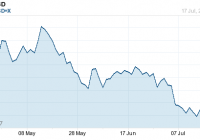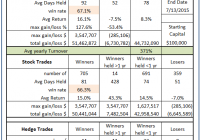Australia’s Getting Comfortable At 2% Cash Rate And Is Expected To Maintain
Summary Australia’s last two rate decreases have begun to spur the economy. The RBA will likely cite progress and hold steady at the current 2 percent rate at the August policy meeting. Australia looks profitable in the long term, but the market will not react much to policy announcement. Why Australia Won’t Lower Rates Amid an environment of global easing, lowered interest rates and weakening currencies, Australia’s RBA will have a tough decision to make concerning its own interest rate at the monetary policy meeting on August 4. Over this past year, Australia has begrudgingly cut its rates twice in order to spur economic growth as a result of lowered domestic demand and weak job growth. Since its initial 25 basis point cut in February, the accommodative policy has spurred borrowing and lending, improved the housing market, and weakened the Australian dollar against the U.S. dollar. As the Australian dollar continues to decline, currently worth US74 cents, down 9.7 percent from the beginning of the year, we can expect to see an improving trade deficit and an accompanying natural economic stimulus to the labor market in the upcoming months. RBA Governor Glenn Stevens feels that this depreciation is good news for Australia – the boost is necessary for its economy to recover , especially considering the intense pressure on its inflation level due to lowering commodities prices. All of these factors will be taken into account when policy makers determine whether to maintain its 2 percent cash rate, or cut rates further. Given its current position, it is unlikely that Australia will feel the need to further spur the economy via monetary policy – at least in 2015. Instead, the announcement will likely cite the recent improvements and maintain steady rates, with the intention to further monitor data in upcoming months. While several analysts expect rates to dip down to 1.75 percent by the end of the year, that sort of cut doesn’t make sense over this timeline. Australia has not shown as much eagerness in resorting to these accommodative measures as Asia, Europe, and now Canada have; consequently, they are unlikely to jump to a third cut so soon. With the Federal Reserve expected to liftoff rates in September or early 2016, there is even more reason for Australia to wait out the clock and see how a U.S. tightening could impact both the exchange rate and exports. As a result, the RBA will most likely maintain its 2 percent rate at the August meeting. How To React When Australia lowered its cash rate in February, the Australian stock market saw an initial surge that led to a steady climb as investors began to feel more comfortable with the economy’s future prospects. The May announcement led to a similar initial surge, but was not followed by the steady climb, as the expected easing was mostly priced in over previous months leading up to the announcement. However, in June when the RBA maintained its current rate, the stock market hardly reacted, and instead, slightly dipped over those following weeks. In looking at this historical pattern, the market will likely not jump at the news of maintained policy, meaning it would not be a very profitable short-term investment. However, with the conditions slowly improving in Australia and an outlook that supports future growth, a long-term investment with Australian exposure would likely perform well over several years, as its policy is gearing it up for continued growth and stability. The iShares MSCI Australia ETF (NYSEARCA: EWA ): This Australian ETF closely tracks the Australian index with a beta of 1.02. While on an overall downward trend since January, it has ticked up 4.2 percent from opening to close of this past week. Disclosure: I/we have no positions in any stocks mentioned, and no plans to initiate any positions within the next 72 hours. (More…) I wrote this article myself, and it expresses my own opinions. I am not receiving compensation for it (other than from Seeking Alpha). I have no business relationship with any company whose stock is mentioned in this article.

